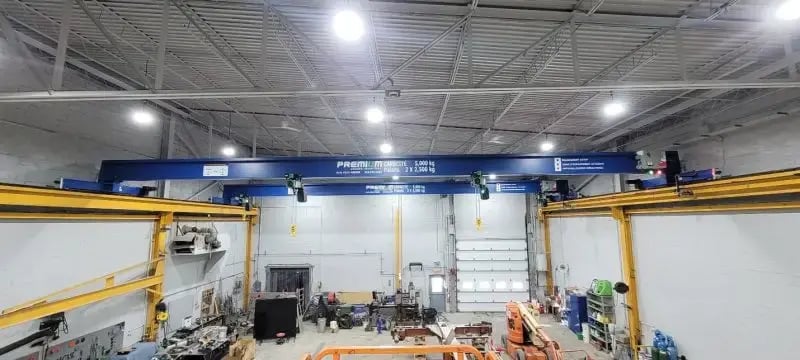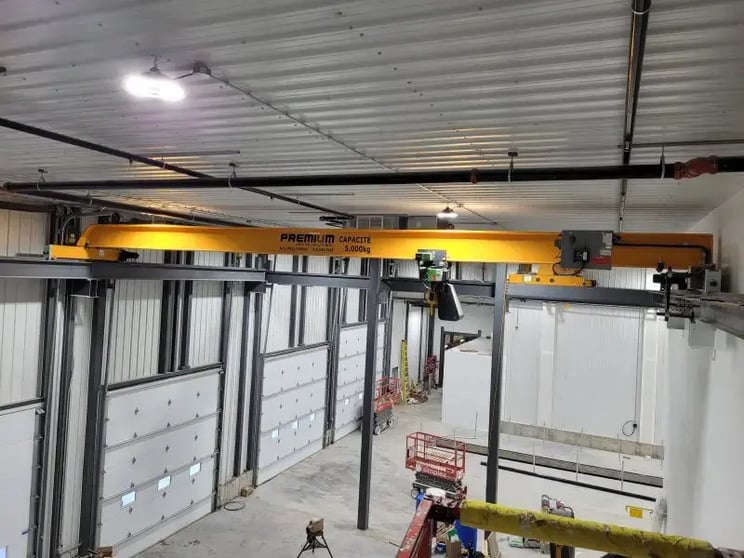-
PRODUCTSreturn
-
SERVICES AND PARTS
-
ABOUT US
Crane project in a new building: avoid the pitfall with 5 checks
6:38
Planning a new industrial building project is complex. There are many elements to plan and organize. We often think of offices, machinery or layout. But have you thought about overhead cranes? Failure to include this element could have consequences: the building may not be suitable for your lifting needs. It’s true, you can always make last-minute changes to adjust. But getting off to the wrong start can mean extra costs, delays and lost productivity.
So, how can you ensure that the lifting equipment in your new building project is properly planned? What are the pitfalls to avoid? With 15 years in the industry, Premium Industrial Group has delivered numerous new building projects, working in close collaboration with many Quebec contractors. We’ve overcome many challenges in these projects. That’s why, in this article, we’re sharing a little secret with you: the pitfall to avoid to prevent a false start! Plus, you’ll discover 5 things to check with your overhead crane specialist to make sure your building will be suitable for your lifting needs.
Here are the 5 things :
- The application
- The height of the building
- The overhead crane type
- The runway tracks positioning
- The building mechanics
That way, you’ll avoid unexpected costs and hassle. But let’s start by identifying the trap so you don’t fall into it!

The pitfall of an overhead crane project in a new building: not involving your supplier from the beginning
The biggest pitfall to avoid is not including the overhead crane manufacturer at the very start of the project. This specialist can give you valuable advice to avoid problems later on. When should you consult him? As soon as the building is designed. He can help you plan your building so that it is adapted to your lifting needs.
What are the 5 things you should check with your specialist before designing your new building, and why?
1st check: identify the application to define needs
This is the most important check. It will often determine many other elements of the next verification steps. It’s about what you want to do with your overhead crane, your lifting operations. This will determine, for example, whether you need a single or multi-crane solution, or whether your overhead cranes will have one or multiple hoists. These choices will have an impact on lifting height, overhead crane type, runway track positioning, and so on. In short, without this prior analysis, the consequences for your project could be far-reaching, and have an unpleasant domino effect!
2nd check : determine the height of the building to avoid disappointments
As our article The 5 solutions to increase the lifting height states, the clear height is a key element in obtaining the desired lifting height for your operations, but also for other reasons. For example, do trucks need to be able to travel under the overhead crane? If the building isn’t high enough, costly modifications may be necessary. It’s best to think ahead from the outset, because once the building has been erected, there are little affordable solutions.

3rd check : decide which type of overhead crane you need
Which type of overhead crane suits your needs? Top-running or under-running? Although top-running cranes are the most common type of overhead cranes, it is worth considering. Why? If the best option for you is indeed a top-running overhead crane, you’ll need a runway track attached to the columns of your structure. But in the case of an under-running crane, it will be supported by your building’s girders. How do you know which one is right for you? By consulting your crane manufacturer. When analyzing your needs, he will make the right recommendation and you can then design your building structure accordingly. But if not, you’ll most likely have to adapt it to the design of your building, which may not be ideal.

4th check : decide on track positioning for your operations
Where will your tracks be positioned? In which direction will they be installed? Where will your loading and unloading come from? Why all these questions? The positioning of your crane runways must be in line with the location chosen for access to heavy loads, especially by your trucks. If you think about this after the building has been designed, it could lead to constraints, additional costs and delays. The experience of your lifting specialist will certainly be valuable in this area.

5th check : ensure that the building’s mechanical systems do not interfere with the overhead crane
Elements such as lighting, ventilation, rain drains or garage doors can impede the movement of the overhead crane (see our article Managing clearance and avoiding obstructions leads to unhindered installations). Good planning avoids conflicts between the mechanical equipment installed on the building and the trajectory of your overhead crane. For example, when modifications are made to your overhead crane after it has been manufactured due to an unforeseen obstruction, costs and delays can be added.

Bonus tip : avoid surprises by checking inclusions
Certain elements, such as rails or end blocks, are sometimes included in your contractor’s construction contract, but not always. So be careful what you include, and make sure everything complies with current standards. For example, it’s important to check that the rail selection had been validated by your overhead crane supplier, and that the installation complies with CMAA alignment tolerances (see attached table).
Don’t wait any longer!
Some industrial building owners have experienced disappointment during their overhead crane project. Therefore, it’s wise to involve your specialist early in the process for your building that will contain lifting equipment. Application, lifting height, overhead crane type, runway tracks and building mechanics are all elements that can disrupt your project if not considered before your building is designed. Save yourself the inconvenience of having to rethink your operations! Install a solution based on your operations, not your building! Find out more about these elements in our article Need an overhead crane: Where to start?
Estimating tools are available to validate certain data related to your building’s design. Ask your overhead crane specialist for more information. Fill in the form at the bottom of the page BEFORE designing your building, and our specialist will help you don’t forget anything.
Manager and partner at Premium Industrial Group
Learning Center
Whether you're an expert or know nothing about cranes, you'll find everything you need to know HERE.






